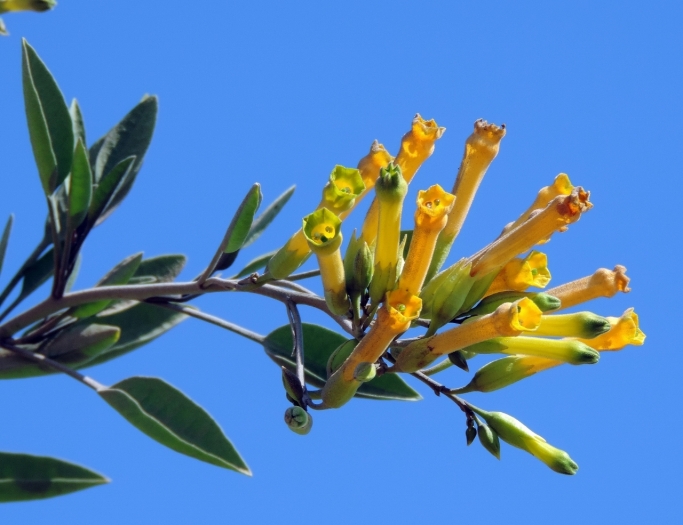Tree Tobacco
(Nicotiana glauca)
Tree Tobacco (Nicotiana glauca)
/
/

i_c_riddell
CC BY 4.0
Image By:
i_c_riddell
Recorded By:
Copyright:
CC BY 4.0
Copyright Notice:
Photo by: i_c_riddell | License Type: CC BY 4.0 | License URL: http://creativecommons.org/licenses/by/4.0/ | Rights Holder: i_c_riddell | Publisher: iNaturalist | Date Created: 2020-08-02T14:01:21-07:00 |






















Estimated Native Range
Summary
Nicotiana glauca, commonly known as Tree Tobacco, is a semi-evergreen shrub or small tree native to the arid zones of Argentina and Bolivia. It has adapted to a variety of disturbed habitats, including riparian zones, roadsides, and urban areas, often where other plants struggle to survive. In its native South America, it is typically found in dry, open areas such as scrublands and riverbanks. Tree Tobacco can grow over 7 feet tall, with thick, rubbery, bluish-green leaves and yellow tubular flowers that bloom throughout the year in warmer climates, attracting hummingbirds and other pollinators.
Tree Tobacco is valued for its drought tolerance and ability to thrive in poor soils, making it a suitable choice for xeriscaping and restoration projects in arid environments. However, its invasive potential outside its native range should be considered before cultivation. It requires minimal water once established, prefers well-drained soils, and can tolerate full sun to partial shade. There are no popular garden cultivars due to its invasive nature and the fact that all parts of the plant are highly toxic if ingested. Tree Tobacco can spread aggressively and outcompete native flora, posing a significant ecological threat. It is also prone to pests such as aphids and whiteflies.CC BY-SA 4.0
Tree Tobacco is valued for its drought tolerance and ability to thrive in poor soils, making it a suitable choice for xeriscaping and restoration projects in arid environments. However, its invasive potential outside its native range should be considered before cultivation. It requires minimal water once established, prefers well-drained soils, and can tolerate full sun to partial shade. There are no popular garden cultivars due to its invasive nature and the fact that all parts of the plant are highly toxic if ingested. Tree Tobacco can spread aggressively and outcompete native flora, posing a significant ecological threat. It is also prone to pests such as aphids and whiteflies.CC BY-SA 4.0
Plant Description
- Plant Type: Shrub, Tree
- Height: 6-20 feet
- Width: 6-6 feet
- Growth Rate: Rapid
- Flower Color: Yellow
- Flowering Season: Spring, Summer, Fall
- Leaf Retention: Evergreen
Growth Requirements
- Sun: Full Sun
- Water: Low
- Drainage: Medium, Fast
Common Uses
Drought Tolerant, Low Maintenance
Natural Habitat
Native to the arid zones of Argentina and Bolivia, often found in dry, open areas such as scrublands and riverbanks
Other Names
Common Names: Tree Tobacco, Tobacco Tree, Palqui Inglés, Tobacco-Bush, Wild Tobacco, Belén, Mustard Tree, Brazilian Tree Tobacco
Scientific Names: , Nicotiana glauca, Nicotiana arborea, Nicotiana arborea, Nicotiana glauca f. genuina, Nicotiana glauca f. lateritia, Nicotiana glauca var. angustifolia, Nicotiana glauca var. decurrens, Nicotiana glauca var. grandiflora, Nicotiana glauca var. typica
GBIF Accepted Name: